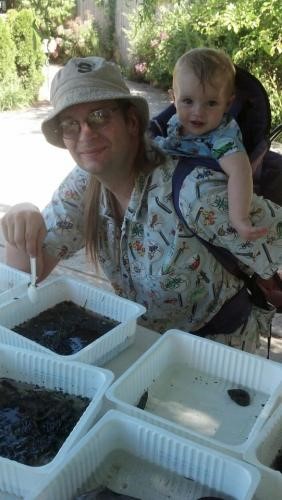Science ideas for young children: Wild wacky water critters
Look at critters in the water to determine the health of your environment.

Children are fascinated by creepy crawly critters. Many people are surprised by the number of these creatures you can find in the water. Many of these critters are insects, but not all of them. This article is part of a series on science activities about the natural world that anyone can conduct with children. Michigan State University Extension recommends this be done within a family, in a day-care setting, as part of school activities, a 4-H club or with any group working with young children.
Catching the critters
With more than 20 years of looking at “water bugs,” I have found a creek or lake without any life only a few times. If you have a creek, ditch, pond or lake near you, you probably will find some of these bugs. Go into the water with boots, waders or old tennis shoes and a net. Try to get into the parts of the water around logs, big rocks, gravel and plants. If you are in a river or stream, place your net so the water is flowing into it. Kick up the bottom with your feet, and the critters will come loose and get caught in your net. Areas where the water undercuts the stream bank are good too, especially where roots are dangling down. Try to get leaves and sticks, but not mud and sand. This can be very difficult, but try your best.

Have two white trays for sorting the critters. White trays allow you to see the critters better. Dish pans work great for this, but you can also use leftover restaurant takeout trays or ice cube trays, which allow you to sort critters into different compartments. Put a little water in both trays. After you catch the critters in your net, dump them the tray, then use plastic spoons to move the bugs from the tray with the leaves and sticks to a tray with clear water.
Identifying the critters
The University of Wisconsin created an excellent key streams and Cornell has created one for ponds. Both will help in identifying the bugs. To use these keys, you need to look at the words, not just the pictures. For young children who cannot read, you will need to ask them questions. For example, does the critter have a shell like a snail, or no shells? Does it have legs or no legs? How many legs? These questions will eventually lead you to a picture.
What do they tell us?
Some of these bugs can live in nasty, polluted water and survive. Some critters will die if the water has just a small amount of pollution. Some require clean gravel or rocks for homes, while others can live in mucky areas.
After you identify the critters, you can sort them by their water quality requirements: high quality, medium quality or low quality. Enjoy exploring the world of wacky water critters!



 Print
Print Email
Email




